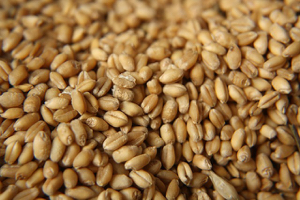 🖨️ Print post
🖨️ Print post
This nutrient-dense heritage grain recipe is a great low-gluten choice when you use the einkorn option. It can be cooked and eaten cold for a tasty, healthy meal during the hot summer months when cooking is something you may want to avoid.
Nutritional Comment:
https://www.seleneriverpress.com/ancient-grain-primer-taking-a-closer-look-at-nutrient-dense-grains/
Einkorn: With a long history of cultivation dating back 9,000 years or so, einkorn has a simple chromosomal structure, low-gluten, and a high-lutein content that supports eye health. Einkorn can be consumed by many people who would otherwise have a bad reaction to readily available commercial wheat.
Emmer (Farro): Historically, emmer (also known as farro), predates einkorn. Emmer holds the distinction of containing more protein than any other member of the wheat family, a whopping 28 percent.
—Recipe adapted from Bluebird Grain Farms. The author of this recipe recommends a combination of curly and Tuscan kale.
Ingredients
- 2 cups whole grain einkorn or emmer farro, dry
- 2 cups warm filtered water plus 4 tablespoons whey, yogurt, kefir or buttermilk
- 1 tablespoon organic virgin olive oil
- 2 tablespoons organic butter
- 1 large shallot, cut into long, thin slices
- 1 teaspoon Italian dried herbs
- Sea salt, to taste
- 4 bunches (16–18 stems) kale, stems removed, washed, and coarsely chopped
- ⅛ cup dry white wine
- 2 cups fresh steamed artichoke hearts, quartered
- ½ cup feta cheese
For the Creamy Artichoke Dressing:
- 2 cups fresh steamed artichoke hearts, quartered
- ½ cup organic virgin olive oil
- 3 tablespoons white balsamic vinegar
- 2 tablespoons freshly squeezed lemon juice
- 2 tablespoons shallot, minced
- 2 cloves garlic, minced
- 1 teaspoon Italian dried herbs
- 2 tablespoons honey mustard
- Sea salt and pepper, to taste
Instructions
- Soak grain in warm water mixture for at least 7 hours and as long as 24 hours. Drain.
- Bring 4-6 cups salted (1 T. sea salt) filtered water to a boil in medium-size pan. Add einkorn or emmer farro. (Grain should be covered with water about ½ inch above the grain.) Simmer on low heat (50–60 minutes for emmer farro or 20–25 minutes for einkorn). Drain and set aside to cool. (This step can be done up to 5 days advance.) Alternatively, you can use a rice cooker for this step (use the brown rice setting). You will want 2 cups einkorn or emmer farro to 3 cups water.
- In a large saucepan over medium heat, heat olive oil and butter. Add sliced shallot and simmer until translucent (8–10 minutes). Add Italian herbs and a dash of salt, and sauté for 2 minutes. Simmer chopped kale separately for a scant 8 minutes according to page 386 of Nourishing Traditions. Add chopped kale and white wine to pan and transfer immediately to a large bowl to cool. Once kale mixture is cool, add cooked emmer farro or einkorn. Mix in quartered artichoke hearts.
- Prepare dressing: Place all ingredients in a blender and process until smooth. About 10 minutes before serving, toss dressing with salad and sprinkle with feta cheese.
🖨️ Print post


For those with pre-diabetes, less sugar and excessive carbs – even if they are whole grain, are required. Adapting this recipe to my own needs would require elimination of wine, balsamic vinegar (very high in sugar), and honey mustard, replacing the vinaiger with red wine vinegar, and the honey mustard with unsweetened mustard. Lastly, I would cut down by two thirds the amount of grains and ad in an animal protein such as turkey sausage or chicken. Lastly – I was under the impression that Weston Price advocated long slow traditional cooking of tough greens. Kale requires more than steaming. The goal is not to achieve an attractive color but rather to release vitamins. Long slow cooking is preferred both for digestion and for nutrients.
Vijaya,
Thanks for pointing out that kale requires more than steaming. I have adjusted the recipe.
Thank you for making some very helpful comments. It’s much appreciated! I do agree and have requested that the kale indicate that it should be simmered for 8 minutes according to Page 386 of Nourishing Traditions. That being said, this recipe and possibly others cannot necessarily be composed to meet the more strict requirements for those who are in any stage of diabetes. I am glad that you are able to take an otherwise great recipe meant for the average population and readapt to your own needs and requirements. Maybe you could compose some good recipes that suit your fancy and especially if they had lots of butter in them, and that additionally meet those requirements. If you emailed them to me along with your permission to use them, I would happily include them in one or more of my blog posts and/or some other material that I write and give you credit.
Thanks again, and keep coming back!
Maria Atwood, CNHP
Thank you for this recipe. We were given kale from our community garden and my husband didn’t want to eat it until I made this! It was so yummy. We used balsamic vinegar since we didn’t have red wine, avocado oil since we had no olive oil, and Dijon mustard since we didn’t have honey mustard. Still very yummy! 🙂 We will make this again.